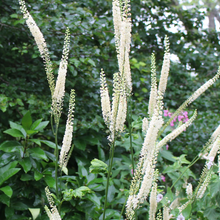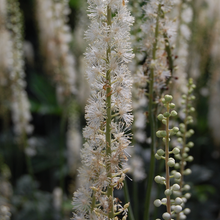Cimicifuga actaea 'Racemosa' is a striking late blooming perennial admired for its tall elegant spires of fragrant white flowers and deep green dissected foliage. Blooming in late summer to early fall, it adds dramatic vertical presence and a sweet musky scent that lures in pollinators. It performs especially well in rich shaded garden beds and lends a bold architectural quality to woodland borders or moist perennial plantings. Its blooms appear as tapering bottlebrushes, rising above the foliage and gently arching with the weight of nectar heavy visitors.
Height & Spread: 48 - 72 in x 24 - 36 in
Bloom Time: Late summer to fall
Light Requirements: Part shade to full shade
Soil Preference: Moist, fertile, humus rich soil
Watering Needs: Moderate to high; prefers consistent moisture
Deer Resistance: Foliage and roots are typically avoided by deer
Native Status
This selection is derived from Actaea racemosa, a species native to eastern North America. It is naturally found in wooded slopes, ravines, and moist thickets from Georgia to Ontario.
WILDLIFE & INSECTS
Butterflies
- Attracts butterflies such as Great Spangled Fritillary, Red Admiral, and Eastern Comma with its long blooming nectar rich spires.
Bees
- Visited by native bumblebees, sweat bees, and carpenter bees, which are drawn to the copious late season nectar.
Moths
- Evening fragrance draws moths including the White Lined Sphinx and other nocturnal pollinators during twilight hours.
Birds
- Songbirds such as thrushes and catbirds may forage among its seedheads and use its dense structure for shelter in shady areas.
Spacing & Landscape Use
Spacing Recommendations
- Space 24 - 36 in apart to allow for full clump expansion and airflow in shaded borders or under tree canopies.
Landscape Placement
- Well suited for woodland gardens, shade borders, or moisture retentive naturalistic plantings where bold texture and upright bloom spikes are desired.
Companion Plants
- Gillenia trifoliata (Bowmans Root) - Offers delicate white flowers earlier in the season with fine foliage that complements Cimicifuga's bold form.
- Asarum canadense (Wild Ginger) - Low growing and shade tolerant, this plant provides dense ground cover and pairs well with taller companions.
- Polygonatum biflorum (Solomons Seal) - Arches gracefully around the base of Cimicifuga and contributes layered vertical structure.
- Arisaema triphyllum (Jack in the Pulpit) - Adds springtime interest with unique flower structures and bold foliage in similar woodland settings.
- Phlox divaricata (Woodland Phlox) - Blooms earlier in spring, offering seasonal progression and soft texture beneath tall flower spires.
- Dryopteris marginalis (Marginal Wood Fern) - Adds evergreen fronds and a cooling contrast in texture near the base of taller flowering plants.



